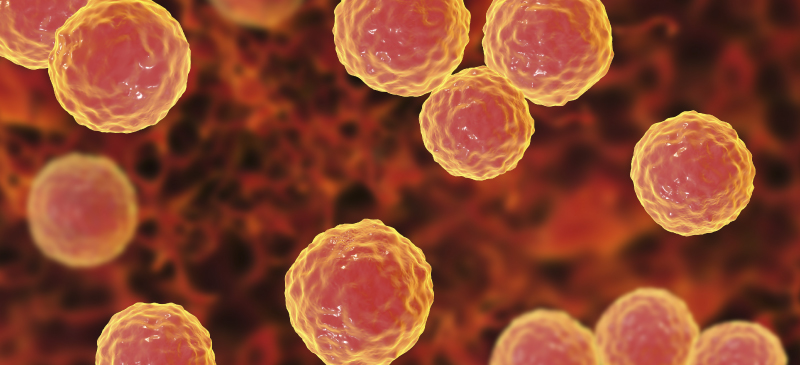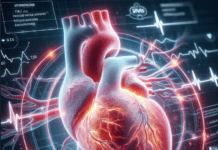Each year in the U.S., about 34,000 patients are admitted to the hospital for infective endocarditis.
While endocarditis, a condition that affects the inner lining of the heart, is not very common, many risk factors can increase your chance of dealing with this condition.
For example, having gum disease, various bacterial or viral infections, a weakened immune system or an autoimmune disorder, a pacemaker, or taking medications like antidepressants and diuretics can all increase susceptibility.
Depending on the underlying cause of the condition, sometimes heart inflammation develops slowly and is mostly asymptomatic (chronic endocarditis),
while other times it happens suddenly and becomes life-threatening quickly (acute endocarditis).
Can you recover from endocarditis? Most of the time, yes. However, in some cases, endocarditis will become severe enough to trigger heart failure, a stroke, or to become life-threatening.
While antibiotics and sometimes surgery are the main treatments used to manage endocarditis,
other natural remedies can help reduce your risk for complications or reoccurring episodes, too — such as practicing good oral/dental hygiene, eating a healthy diet, staying hydrated, and limiting drug use and toxin exposure.
What Is Endocarditis?
The definition of endocarditis is inflammation and common infection of the endocardium, which is the inner lining of the heart’s chambers and valves.
The most common type is called bacterial endocarditis (or infective endocarditis), which is caused by bacteria entering the heart from another part of the body via the bloodstream.
Endocarditis is one of three main types of heart inflammation; the other two types are myocarditis (inflammation of the heart muscle) and pericarditis (inflammation of the tissue that forms a sac around the heart).
All of these heart problems are more common in men; studies show that endocarditis and pericarditis occur twice as often in men as in women.
Genetics, older age, medical history, and lifestyle habits also affect someone’s risk of developing endocarditis.
Signs and Symptoms
Is endocarditis painful, and is the condition always visible? Symptoms vary widely depending on how severe heart inflammation becomes. The most common endocarditis symptoms include:
Fever and chills
- Shortness of breath
- Chest pains
- Heart murmurs and irregular heartbeats (either abnormally fast or slow)
- Blood in the urine
- Enlarged spleen, which can cause indigestion or feeling uncomfortable when eating, pain and tenderness, usually on the upper left side of the abdomen
- Fluid buildup in your arms or legs (peripheral edema)
- Red or purple spots or bumps on your skin (such as on your hands or feet) or places that indicate broken blood vessels
- Abdominal pain, loss of appetite and weight loss
- Fatigue and muscle, joint and back pains
- Night sweats
- Depending on where an infection started, bleeding gums or other signs of an oral infection
- If a virus is a cause, symptoms like cough, runny nose, or gastrointestinal symptoms
Complications Due to Endocarditis
What are the symptoms of bacterial endocarditis? Infective/bacterial endocarditis causes many of the symptoms described above, especially those associated with a fever.
Bacterial endocarditis is considered a serious condition as it can damage the heart valves and sometimes be life-threatening if it isn’t treated correctly.
Other complications that can sometimes result from endocarditis, especially if it’s left untreated and becomes severe, include heart arrhythmia (or irregular heartbeat), blood clots, increased risk for stroke or heart failure, and sepsis (a life-threatening blood infection).
Sometimes an embolus, or a clump of bacteria or fungi, will form on the damaged heart valves and then break off and travel to the brain, which can cause stroke, meningitis, or an infection called a brain abscess.
An embolus can also potentially go to the lungs, spleen, or kidneys and can cause lung damage or a lung abscess or blocked blood flow to the organs.
If bacterial endocarditis causes renal (kidney) problems, this can result in blood cells leaking into the urine and hematuria (blood in the urine).
Renal problems trigger by endocarditis can potentially be life-threatening if the infection doesn’t respond to antibiotics.
Infective endocarditis can also result in pulmonary embolism (blockage in one of the pulmonary arteries in your lungs, usually by a blood clot) and often respiratory symptoms that are similar to pneumonia, such as cough, hemoptysis and chest pains.
Endocarditis Causes and Risk Factors
What is the most common cause of endocarditis?
A bacterial, viral, or fungal infection is the No. 1 reason people develop inflammation of the heart’s inner lining.
These occur due to pathogens such as bacteria or fungi entering the bloodstream and traveling to different tissues/organs.
Endocarditis symptoms typically develop about one or two weeks after someone has a viral or bacterial infection or another illness.
Inflammation stems from the immune system and develops in response to things like a viral or bacterial infection, or another medical condition that damages the heart.
It’s the body’s way of trying to repair and heal itself, although it can cause problems in the process.
When an infection is the cause of bacterial endocarditis, it’s most common for the disease to start in the mouth and then travel to the heart.
Sometimes bacteria can also travel from the skin, respiratory system, or urinary tract.
When someone has endocarditis clumps of bacteria, fungi and blood cells accumulate on the endocardium, usually in the heart valves but sometimes also in the heart chambers. It’s possible for these clumps to break off, enter the bloodstream, and move to the other parts of the body where they can cause issues like reduced circulation and infection.
Endocarditis causes and risk factors include:
- Having an infection or virus that can spread to the heart. Staphylococcus aureus is the most common type of bacteria that causes endocarditis. Viral infections that can trigger endocarditis include adenovirus, coxsackievirus, herpes virus, influenza (flu) virus, and parvovirus B19. Older adults are more at risk for endocarditis caused by bacteria.
- Dealing with an existing problem with a heart valve, such as a congenital heart defect that causes an abnormality or having a damaged heart valve.
- Having an artificial heart valve or another device in the heart, like a pacemaker or implantable cardioverter-defibrillator.
- Having an autoimmune disease that can damage the heart, such as rheumatoid arthritis or lupus erythematosus.
- Drinking too much alcohol, which can lead to reduced heart function and increase the risk of heart failure.
- Drug use, such as cocaine and amphetamines.
- Poor dental health, which increases the risk of bacterial endocarditis by potentially leading to the accumulation of bacteria in the mouth.
- Undergoing treatments including hemodialysis for end-stage kidney disease, having a central venous line catheter that goes into a larger central vein in your body, radiation therapy to treat cancers or treatments for ischemic heart disease.
- Having an existing medical condition such as cancer, diabetes, an eating disorder, end-stage kidney disease, HIV/AIDS, trauma or injury to the chest or esophagus, or skin disorders such as recurrent infections.
- Taking certain medications that may cause the immune system to become hyperactive, leading to myocarditis or pericarditis that may damage the heart. Examples of drugs that may be problematic include antibiotics such as penicillin, antidepressants, benzodiazepine, diuretics, certain heart medicines (such as amiodarone, hydralazine, methyldopa, and procainamide), certain psychiatric drugs, seizure medicines, possibly some vaccines, and some weight-loss medicines.
- Exposure to environmental triggers that cause the immune system to attack the heart, such as heavy metals like copper and lead or radiation.
Endocarditis Diagnosis
Doctors will not typically screen for endocarditis or similar problems, considering they are somewhat rare, but instead will diagnose endocarditis based on symptoms and several tests.
To make a diagnosis of endocarditis, your doctor will discuss any symptoms you’re experiencing with you (fever, shortness of breath, etc.) and also access your risk factors and medical history.
Diagnostic lab and heart tests that can be used to help confirm a diagnosis include:
- Echocardiography (echo) to look for heart valve problems, problems in the structure or function of the heart, or a thickening of the pericardium
- ECG tests to reveal abnormal heart rhythms
- Imaging studies to look for an enlarged heart, or perform a biopsy of the endocardium, looking for signs of inflammation such as edema, increased lymphocytes, and increased macrophages
- Cardiac computed tomography (CT) or cardiac magnetic resonance imaging (MRI) to check for complications of endocarditis
- Blood cultures to identify bacterium, virus or fungus that is causing the infection in endocarditis
- C-reactive protein (CRP) or erythrocyte sedimentation rate (ESR) to identify increased inflammation
- Complete blood count to look for higher levels of white blood cells, which might indicate infection
Regarding endocarditis prognosis, recovery rates seem to have improved in recent years, thanks to better diagnostic tests and treatments.
One study found that overall mortality due to endocarditis was between 12 percent to 17 percent, down from 25 percent in 1995.
The six-year survival rate is around 72 percent overall, and 80 percent in those who survived the active disease phase.
Conventional Endocarditis Treatment
While myocarditis and pericarditis can sometimes go away on its own and doesn’t always require treatment, endocarditis usually needs to be treated promptly.
Endocarditis needs to be treated right away since this reduces the chance of serious complications.
Treatment will depend on how severe someone’s endocarditis is and the specific parts of the heart that are inflamed or infected,
whether it’s only the lining of the heart’s valves, the heart muscle itself, or the tissue surrounding the heart.
Endocarditis treatment usually involves:
- Use of high-dose antibiotics to help control infection.
- Antifungal medicines to treat fungal infections or prevent them from returning.
- Blood thinners to treat some types of endocarditis.
- In some cases, surgery to fix a damaged/dysfunctioning heart valve. Heart surgery can involve removing heart tissue that has been damaged or severely infected. Surgery can also help reconstruct parts of the heart, such as affected valves.
Prevention and 6 Natural Remedies for Endocarditis Symptoms
1. Prioritize Oral/Dental Hygiene
If you’re at risk for endocarditis, it’s essential to pay attention to your oral health, considering bacteria from gum infections can enter your bloodstream and travel to your heart.
Dentists consider “good dental hygiene” to include daily brushing and flossing, plus regular visits to the dentist at least 1–2 times per year for cleanings and examinations.
If you have a history of gum disease, heart disease, or other risk factors, make sure to get regular dental checkups and talk to your doctor about ways to prevent gum infections.
Some doctors will prescribe antibiotics before dental work and certain types of surgery to limit the risk of infections.
The American Heart Association (AHA) recommends antibiotics before specific dental procedures like those that involve manipulation of gingival tissue or the periapical region of teeth or perforation of the oral mucosa.
Taking care of your skin is another preventative measure.
Practice skin hygiene by regularly washing your skin, showering daily, and carefully treating any wounds, cuts, or incisions.
This will help prevent infections and growth of harmful bacteria.
You can also lower the chances you’ll acquire infections/viruses from other people by avoiding close contact with anyone who has a viral or bacterial infection and always practicing safe sex, such as by limiting the number of partners you have.
Wash your hands regularly, keep your home clean, wash your clothes frequently, and be careful about picking up germs that cause infections from public places like hospitals or doctors’ offices, nursing homes, daycares, schools, universities, and gyms.
2. Avoid Heavy Alcohol Consumption and Drug Use
You can decrease your risk of endocarditis and other heart-related problems by avoiding the use of illegal intravenous (IV) drugs, amphetamines, and cocaine, alcohol, and tobacco.
To avoid “excessive alcohol consumption,” women should have no more than one drink per day, and men should have no more than one or two drinks per day.
If you take any medications that raise your risk for heart problems (like antidepressants, diuretics, psychiatric medications, etc.),
Then discuss alternatives with your doctor that might be more appropriate depending on your medical history and risk factors.
For example, you may be able to switch from using diuretic medications to more natural diuretics like foods, herbs, and supplements that prevent fluid buildup and decrease bloating.
3. Manage Fevers, Aches, and Pains
To help manage symptoms of fever, keep in mind that rest is vital.
Drink plenty of fluids (try coconut water, which provides electrolytes, or peppermint or chamomile tea),
eat mild and bland foods if that’s what you can keep down, consume probiotics, take a lukewarm bath daily, and don’t overdress, which can make you feel hotter.
Exercise may be beneficial for reducing joint pains and improving your energy levels, just be sure that it’s appropriate for you to exercise regularly based on where you are in your treatment journey.
To prevent any heart issues from worsening, do not exercise until permitted by your doctor.
Once your doctor gives you the green light to exercise, stay physically active by doing things like brisk walking, cycling, swimming, yoga, gardening, lifting weights, or riding a bike.
If you notice shortness of breath, pains, or fatigue, then you’re likely doing too much and should rest before gradually reintroducing exercise again.
Other ways to deal with joint pains include applying peppermint essential oil to achy areas, using ice or heat packs, massage, acupuncture, chiropractic treatments, and elevating swollen feet or legs.
Peppermint essential oil can be used topically to improve circulation and reduce muscle tension, while lavender oil is useful for promoting relaxation, easing stress, and helping you fall asleep.
A magnesium supplement can help relax constricted or spasming muscles.
However, you shouldn’t take magnesium without speaking with your doctor first if you have low blood pressure or kidney disease/kidney failure.
If you’re experiencing shortness of breath and coughs, use a humidifier in your home, especially when you sleep at night.
A humidifier can help to loosen mucus and relieve wheezing and limited airflow.
4. Stay Hydrated and Eat An Anti-Inflammatory Diet
To protect your heart and support your immune system, eat a whole-foods diet that includes plenty of vegetables, fruits, high-fiber foods, clean proteins, and healthy fats.
Limit your intake of refined vegetable oils, processed grains, added sugar, trans fats, fried foods, and packaged foods.
- Aim to fill half your plate with fresh produce at every meal. Some of the best choices include all types of leafy greens, berries, carrots, tomatoes, squash, cruciferous veggies like broccoli or cauliflower, asparagus, avocado, cranberries, blueberries, grapes, and mushrooms.
- Other healthy food choices for heart health include flax and chia seeds, almonds and other nuts, olive oil, wild-caught fish, dark chocolate (if caffeine is OK), beans and legumes, fresh herbs, and green tea.
- Limit sodium/salt intake. Sodium (salt) can worsen edema/swelling and aggravate the symptoms of endocarditis. The best way to reduce salt intake is to avoid eating processed foods, including fast food, frozen meals, canned foods, processed meats, cheeses, condiments, pre-made soups, and packaged baked goods.
- Consume bone broth daily, which is another healing food that will supply essential vitamins and minerals.
- Eat probiotic-rich foods because they boost immune function and replenish the healthy bacteria in your gut. Some excellent options include kefir, cultured vegetables (like sauerkraut and kimchi), periapical, coconut kefir, and cultured yogurt.
If you’re being treated with antibiotics, it’s possible that you’ll experience side effects like diarrhea, nausea, and dizziness.
Make sure you’re drinking lots of fluids, especially plain water, herbal tea, and fresh vegetables juices (if you can tolerate them).
Limit the amount of caffeine and alcohol you have. Caffeinated drinks, such as coffee or tea, can cause your heart to beat faster, which can be dangerous if you already have irregular heartbeats.
If you’re dealing with the loss of appetite and losing weight, try eating smaller, calorie-dense meals throughout the day, such as smoothies made with healthy fats, nut butter, and proteins cooked in olive oil or butter.
5. Follow Up With Your Doctor for Routine Care
Once you’ve been diagnosed with endocarditis, it’s essential to follow up with your doctor regularly for monitoring and additional treatments if needed.
According to the National Heart, Blood and Lung Institute, “People with endocarditis have a lifelong risk and repeat events of pericarditis are common in the first 18 months after treatment.”
Keep an eye on your symptoms, since they can sometimes return.
Make sure you understand how often you should be having tests done including blood tests for detecting the bacteria causing endocarditis,
tests to monitor inflammation/C-reactive protein (CRP) levels, and cardiac MRI or echocardiography to look at your heart.
Always visit the emergency room or your doctor right away if you notice symptoms return like chest pain, cough, fever, and shortness of breath.
While you’re recovering, also try your best to avoid any known stressors or risk factors, including any situation that makes you feel anxious or fatigued.
Chronic stress and anxiety can negatively affect your immune and cardiovascular systems.
Prolonged stress is associated with a higher risk of heart disease, high blood pressure, susceptibility to viral or bacterial illnesses, and autoimmune disease flare-ups.
Manage your stress levels as best as you can by doing things like exercise, meditation, journaling, reading, getting a massage, yoga class, etc.
Final Thoughts
- Endocarditis is inflammation of the endocardium, which is the inner lining of the heart’s valves and chambers.
- Causes of endocarditis include: having bacterial or viral infections, a history of heart disease, kidney failure, autoimmune diseases that damage the heart, or reactions from surgery, injury, or certain medications.
- In some cases, endocarditis can lead to complications like blood clots, irregular heartbeats, and heart failure.
- Symptoms of endocarditis vary considerably and can include: fever, chest pain, trouble breathing, edema/fluid retention, joint pain, abdominal pain, and others.
- Natural ways to help manage endocarditis symptoms and recovery include prioritizing oral/dental hygiene, avoiding heavy alcohol consumption and drug use, managing fever, aches and pains, eating an anti-inflammatory diet, and following up with your doctor for routine care.








